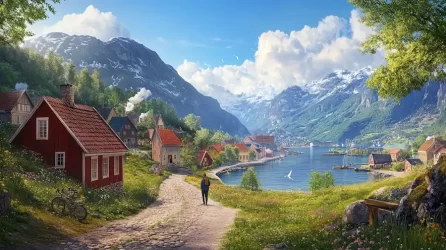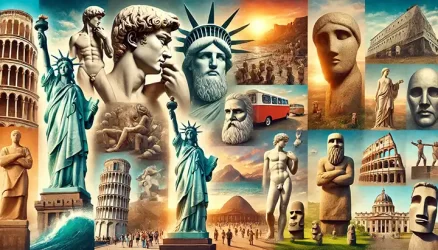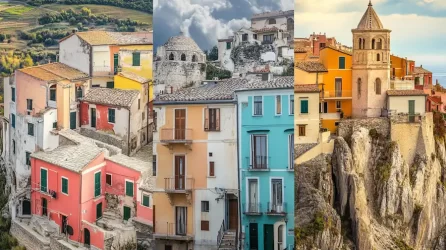Top 10 Iconic Sculptures to Discover in Italy
Italy is renowned for its rich history, cultural heritage, and unparalleled contributions to the art world. Among its most notable creations are the countless sculptures scattered throughout the country, each reflecting Italy’s artistic legacy. Below is a curated list of the 10 most beautiful sculptures you can find in Italy:
1. Michelangelo’s David – Florence

Arguably the most famous sculpture in the world, David by Michelangelo stands as a symbol of Renaissance art. Completed in 1504, the 17-foot tall marble statue depicts the biblical hero David, poised before his battle with Goliath. It is housed in the Galleria dell’Accademia in Florence and is celebrated for its lifelike detail, muscular form, and expression of human strength and beauty.
2. Pietà – St. Peter’s Basilica, Vatican City

Another masterpiece by Michelangelo, the Pietà depicts the Virgin Mary holding the body of Jesus after his crucifixion. Sculpted in 1499, this marble work is one of the few pieces Michelangelo signed. Its emotional intensity and delicate rendering make it one of the most touching religious sculptures in the world, housed in St. Peter’s Basilica.
3. Bernini’s Apollo and Daphne – Rome

Housed in the Galleria Borghese in Rome, Apollo and Daphne is a Baroque masterpiece by Gian Lorenzo Bernini. Completed in 1625, it captures the moment in Greek mythology when Daphne is transformed into a laurel tree as Apollo pursues her. The delicate rendering of leaves and the dynamic movement of the figures showcase Bernini’s unparalleled skill in marble.
4. The Rape of Proserpina – Rome

Also by Bernini, The Rape of Proserpina is another Baroque triumph, located in the Galleria Borghese. Sculpted between 1621 and 1622, it captures the moment when Pluto abducts Proserpina. Bernini’s ability to make marble look soft and flesh-like, as seen in Pluto’s gripping hands, is breathtaking.
5. The Dying Gaul – Rome

One of the most famous ancient Roman sculptures, The Dying Gaul is a moving depiction of a wounded Gallic warrior. Created in the 3rd century BC, it is housed in the Capitoline Museums in Rome. The expression of agony and bravery in the soldier’s face captures the Greek and Roman ideals of heroism in defeat.
6. Donatello’s David – Florence

Donatello’s David was the first large-scale bronze nude statue of the Renaissance. It portrays a youthful David standing triumphantly over Goliath’s head, symbolizing the victory of intellect and courage. Housed in the Museo Nazionale del Bargello in Florence, this sculpture is known for its sensuality and detail.
7. Equestrian Statue of Marcus Aurelius – Rome

One of the few surviving bronze statues from antiquity, the Equestrian Statue of Marcus Aurelius stands on Capitoline Hill in Rome. Dating back to 175 AD, this statue of the Roman emperor on horseback is a powerful symbol of leadership and authority, admired for its grandeur and historical significance.
8. The Veiled Christ – Naples

The Veiled Christ (Cristo Velato) is a marble sculpture by Giuseppe Sanmartino, located in the Sansevero Chapel in Naples. Created in 1753, it depicts the body of Christ covered by a delicate shroud. The intricate detailing of the transparent veil over the body is a remarkable achievement in sculpture, making it a must-see for art lovers.
9. Moses – Rome

Moses, another masterpiece by Michelangelo, is located in San Pietro in Vincoli in Rome. Originally part of a larger tomb for Pope Julius II, the sculpture is famous for its dynamic pose and the intense expression on Moses’ face. His flowing beard and muscular arms demonstrate Michelangelo’s skill in capturing emotion and movement in marble.
10. Laocoön and His Sons – Vatican Museums

Discovered in 1506 and now housed in the Vatican Museums, Laocoön and His Sons is an ancient Greek sculpture that depicts the Trojan priest Laocoön and his sons being attacked by sea serpents. The intricate detailing of the figures’ contorted bodies and the expression of suffering have made this sculpture a powerful symbol of human agony and struggle.
Conclusion
Italy’s sculptures not only reflect the artistic brilliance of the Renaissance and Baroque periods but also tell stories of mythology, religion, and human emotion. Whether in the bustling streets of Rome or the galleries of Florence, these works of art offer visitors a glimpse into Italy’s vast cultural heritage. Each sculpture on this list stands as a testament to the timeless power of art and the enduring legacy of the artists who shaped history.


















